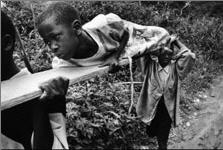Conflict and humanitarian crisis in the Democratic Republic of Congo have taken the lives of 5.4 million people since 1998 and continue to leave as many as 45,000 dead every month, according to a new mortality survey released by the IRC. Conflict and humanitarian crisis in the Democratic Republic of Congo have taken the lives of an estimated 5.4 million people since 1998 and continue to leave as many as 45,000 dead every month, according to a major mortality survey released today by the International Rescue Committee. "The conflict and its aftermath, in terms of fatalities, surpass any other since World War II," says the aid group's president, George Rupp. "Congo's loss is equivalent to the entire population of Denmark or the state of Colorado perishing within a decade. Although Congo's war formally ended five years ago, ongoing strife and poverty continue to take a staggering toll. We hope this week's peace agreement in North Kivu will mean an end to the hostilities and a restart of reconciliation and recovery efforts." The latest mortality survey was conducted last year by the International Rescue Committee and the Burnet Institute and covers the period of January 2006 through April 2007. Researchers visited 14,000 households in 35 districts of Congo's 11 provinces. The final toll combines figures from four previous IRC mortality surveys with data from the newest study. The survey found that mortality remains highly elevated across the country. "Since our last study in 2004, there's been no change in the national rate, which is nearly 60 percent higher than the sub-Saharan average," says Dr. Richard Brennan, director of IRC's global health programs and one of the survey's lead authors. The survey period ended shortly after violence in eastern North Kivu province began to escalate in December 2006. Therefore, the study documents only a fraction of the recent unrest. Brennan points out that prior to the upsurge in violence, there were actually modest decreases in mortality in eastern regions. "These small but statistically important declines coincided with improvements in security, a more robust peacekeeping effort and an increase in humanitarian aid," says Brennan. "Unfortunately the gains in the east have been threatened by the violence in North Kivu." As with the previous surveys, the vast majority died from non-violent causes such as malaria, diarrhea, pneumonia and malnutrition? easily preventable and treatable conditions when people have access to health care and nutritious food. Brennan says the findings confirm that recovery from such a devastating conflict is a protracted process, especially when it follows years of economic and political decline. "When war destroys a country's economy and infrastructure, there's no quick fix," he says. "Significant improvement in Congo's health and mortality will require years of unwavering commitment from the government and the international community and substantial financial investment. Sadly, the humanitarian crisis in Congo continues to be overlooked and funding remains disproportionate to the enormity of need." Complete report: 2007 survey [PDF] New York: Melissa Winkler, +1 646 734 0305, melissa.winkler@theIRC.org For more information, visit: theIRC.org/congocrisis
22 Jan 2008 - Peace Deal in North Kivu, Increased Humanitarian Aid Security Seen as Critical to Reducing Death Toll

Photo: Marcus Bleasdale/ VII
Overall, an estimated 727,000 people died in excess of normal mortality during the latest survey period. Nearly half of the fatalities were among children under the age of five, even though they comprise only 19 percent of the total population.
Previous Congo mortality surveys:
2000 l 2001 l 2002-2003 l 2004
Policy recommendations
IRC's humanitarian aid programs in Congo
Special report featuring a video interview with the IRC's Dr. Richard Brennan
Press Contacts
London: Lydia Gomersall, +44 20 7692 2741, +44 (0) 7779 855 021, lydia.gomersall@IRCuk.org
Vienna: Peter Biro, +43 664 279 3977, +1 646 734 0305, peter.biro@theIRC.org
Photos and footage: Emily.Holland@theIRC.org







